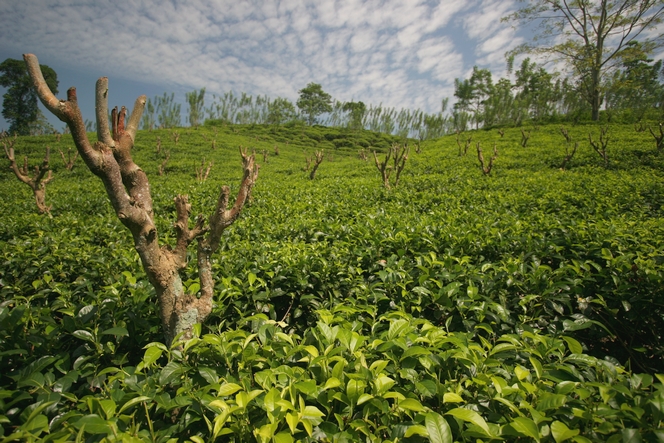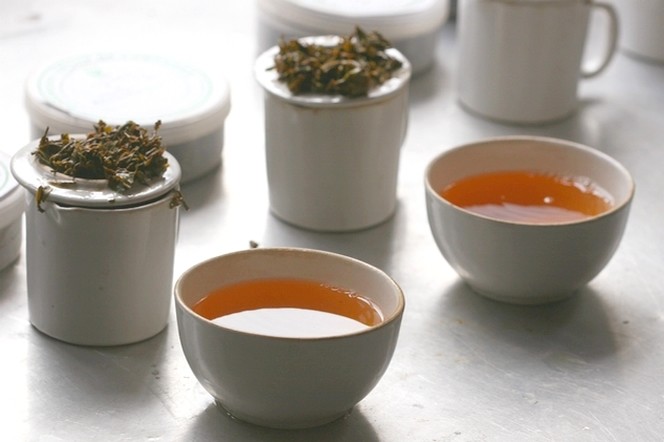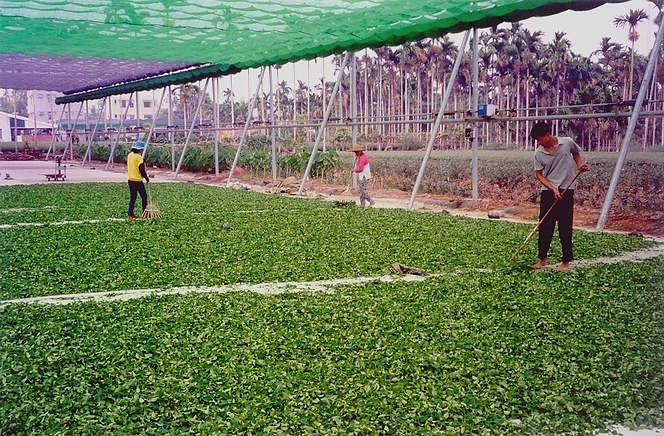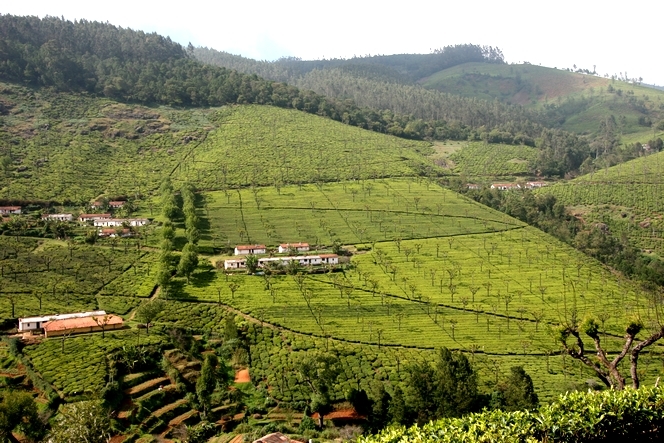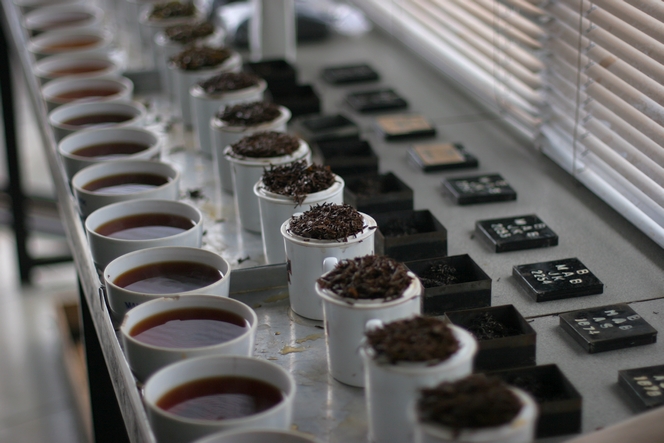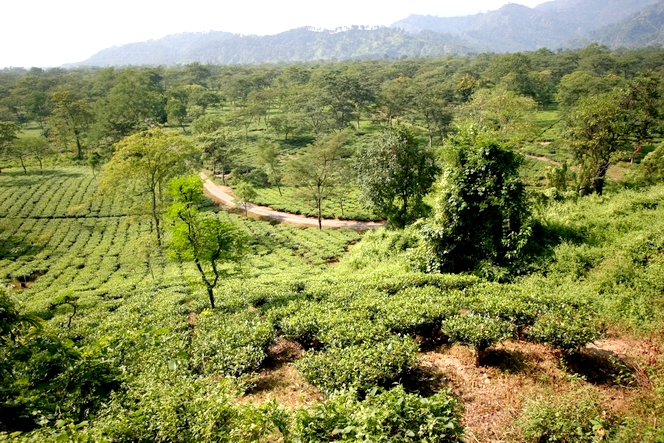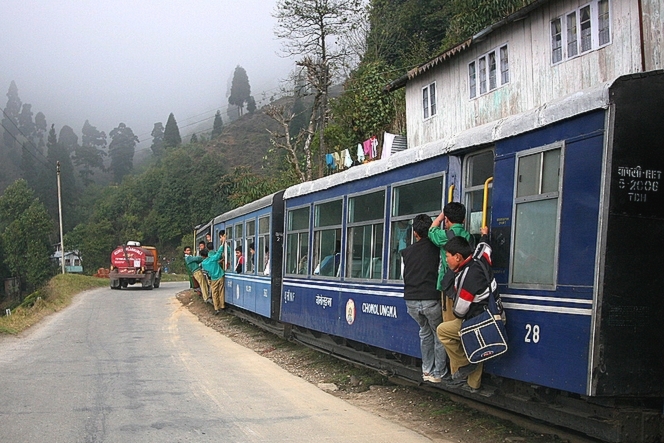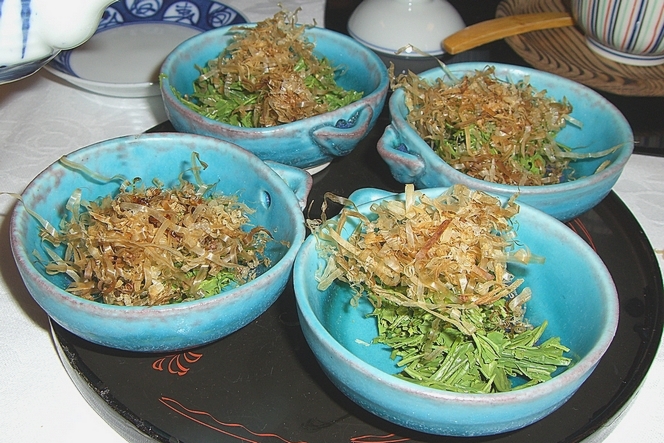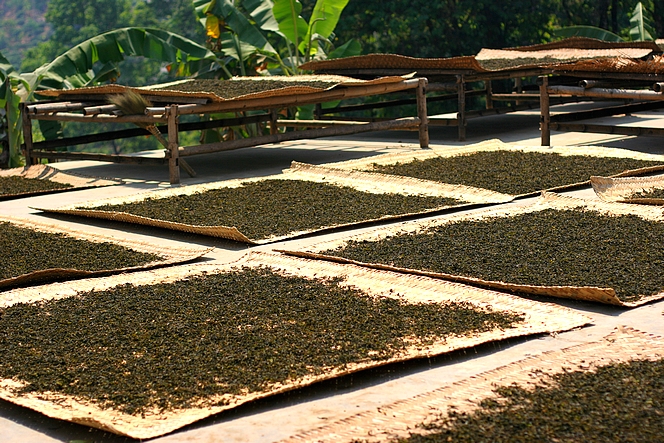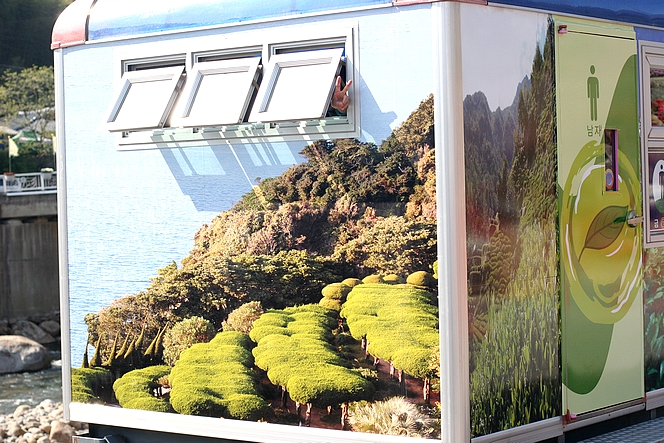On a tea plantation, tea plants are not the only ones that need care and attention: the trees do too. If you want their leaves to give a little shade to the camelias, the trees have to be prevented from growing too tall. So from time to time, they have to be pruned severley, like here near Ivy Hills (Sri Lanka), to be kept low and start up again with renewed vigor.
ARCHIVE FOR 2010
In Barnsbeg like elsewhere, I take the time for tea
Once the tea is infused you have a wait a little bit of time before enjoying it. I grab this opportunity to smell the wet tea leaves and look around the tasting room flooded with northern light. While in the teacup the temperature goes from the infusion temperature (around 85 – 90 degrees for a black tea) to the tasting temperature (around 50 degrees), I take out my camera and turn around the teacups searching for the best possible angle. There’s no hurry here in Barnsbeg (India), life goes on slowly. I take a picture of the tasting set just for the pleasure of capturing a shimmer or a colour, a shadow or a line on the teacup’s surface. And my thoughts go on drifting, just like a travelling wave.
This is call taking time. The time for tea, simply.
In Taiwan, people take great care of semi-fermented teas
In Taiwan, people take great care of semi-fermented teas (wu longs) left to wither outside. The grower first buy an electrical system of open-weave canvases that are moved across to shade the leaves when the sunlight gets too intense. Tea is then aired: it is raked very carefully, for hours, to prevent the leaves from starting to ferment.
Tea plantations form small villages
Some tea plantations run by the British are so vast that several thousand people can live there, scattered across several hundred hectares. In southern India, like here in Thiashola, groups of buildings are home to one, two or three families. These houses form small villages where social life plays an important role. Although the buildings belong to the plantation, they are made available to the families as long as they work on the land. So this means that most houses are handed down from generation to generation.
To select a tea, you have to taste dozens
When we attend professional tea tastings, there is a great number of teas to assess. It can range from three or four to several dozen. Sometimes the teas we taste are all quite similar, like here in Colombo (Sri Lanka). They come from the same area, and you go from one to another, comparing them in turn. First you smell the various infused leaves, then you examine each liquor. In the trade jargon, we call the infused leaf an “infusion”, and the contents of the cup, the “liquor”. (To know more about it: see the article To choose tea, you need to have a good nose).
The dry tea leaf is also presented so that you can look at it, feel and touch it, and get a complete picture of the particular batch you are tasting.
A beautiful landscape doesn’t always make a good tea
A beautiful landscape doesn’t always make a good tea. When I come from Bagdogra (India) and start the three-hour ascent into the Himalayan foothills, I love nothing more than stopping and admiring the view once I get through the stifling heat of Siliguri. The land is no longer completely flat, the city has disappeared from sight, the traffic and the horns have calmed down. Goats doze on the roadside. You start seeing far away above the trees and it helps bearing the heat: you suffocate much less when looking at a clear view. With the gentle breeze and the smell of the earth, I always stop walking between the tea plants.
Actually, I must say that they’re not good tea plants. People say that they are Darjeelings, but it’s not quite true: they are just outside the Darjeeling “appellation”, but close enough for dishonest merchants to use them to bulk out the real Darjeelings and cheat the buyers. This explains how there is four times as much Darjeeling tea sold worldwide than is actually produced.
Never mind, it’s the landscape that is worth admiring here. It is truly magnificent. I’m really attracted to this Terai plain, which used to be a jungle until the British cut down all the trees. People say you sometimes see wild elephants charging around and leopards. I feel good here, so I walk and walk before continuing on my way to Darjeeling. Why beeing in a hurry when it’s so beautiful around?
On the way to school in Kurseong
Almost the beginning of the new school year ! In Kurseong (India), these schoolboys jump on the Toy Train’s bandwagon and hold on the outside, not because the train is packed, but simply because it’s actually more fun doing the journey with the head in the breeze.
They laugh, say hello to the people they know when the train crosses a village: a pleasant way to get to school.
In Japan, people eat green tea
In Japan, people sometimes eat green tea leaves. In that case, it’s usually exceptional teas whose leaves have been previously used to prepare tea.
You can see how it is prepaped on the picture: after dropping the wet tea leaves into a container, you add skipjack chips and sprinkle a little bit of soy sauce over the top. It gives you a small tea leaves salad that’s absolutely delicious.
Here, in Asahina (Shizuoka prefecture, Japan), the tea used is a great “Kabuse Cha” or “shade tea” manufactured by Mister Maeshima Tohei, one of the most well-known farmers of the area.
Xishuangbanna, celestial garden of Pu Er
If you ever go to Xishuangbanna (I wish you to because this region of southern Yunnan (China), watered by the Mekong, offers landscapes of great beauty), you might see these mats set on the ground, on which tea is dried.
This is the first step in the making of the famous Pu Er, both considered great for some, terrifying for others, because of its strong smell. Here however, it’s only the first stage of production: the leaves wither in the sun for 24 hours, giving off a delicious perfume. It’s only later, when the same leaves will ferment 45 days that their smell will change considerably. I’ll talk to you again later about it. Meanwhile, enjoy this Xishuangbanna I love, this Celestial Garden as they sometimes call it, with its mountains covered by jungle, its breathtaking gorges. It is both wild and calm. In this part of China, we can really breathe.
Hadong’s Tea Festival
When the village of Hadong (South Korea) holds its Tea Festival each year, the organizers don’t do things by halves. People come from far away to stroll along the aisles where each producer offers you to taste their tea. The whole village is embellished for the occasion and there isn’t a single roundabout or lamp post that isn’t decorated with sophisticated structures made from camellia leaves. Even the public toilets provided for the many visitors on that day are beautifully decorated with terraced tea gardens and flooded with evening light tumbling down towards the sea. I was so stunned by the use made of this dream-like landscape that I didn’t even see anything. It’s only when looking back at the picture a few days later that I noticed the hand of a joker coming out from the landscape, making the victory sign V.

